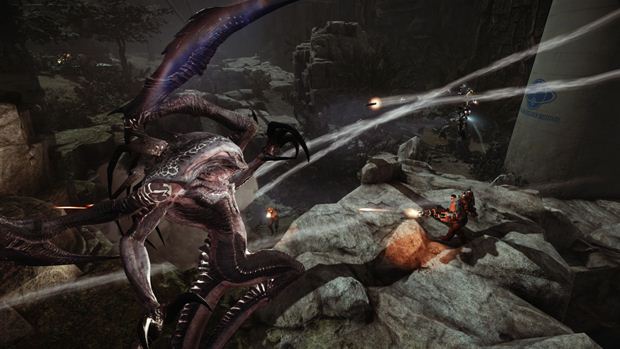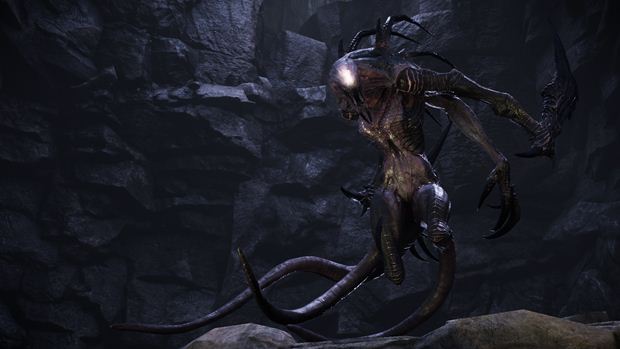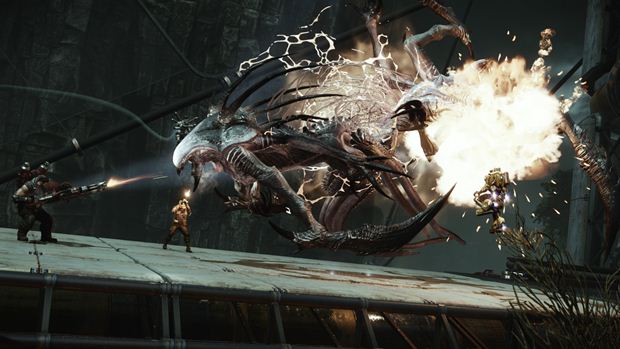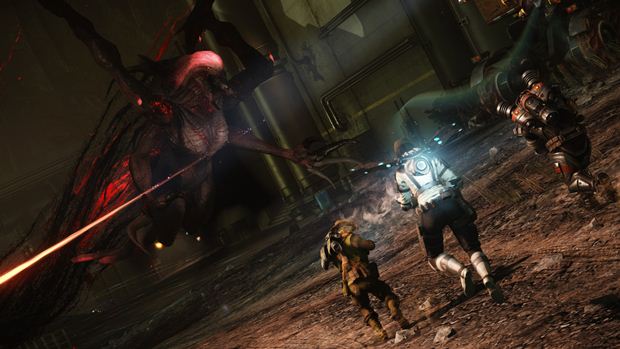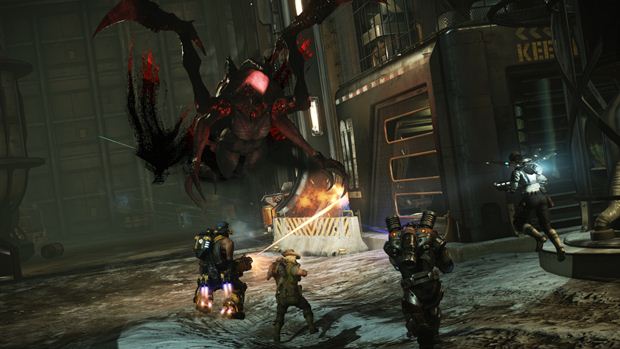
Upon first glance as with the promotion surrounding the game it’s easy to look upon Evolve as an iteration of Turtle Rock Studio’s most popular title Left 4 Dead. The attention being given to the online and local four player Co-op strengthens this outlook and with that being said, it’s not necessarily a bad thing.
Left 4 Dead which was originally released in 2008 with it’s sequel following shortly behind in 2009 is regarded as one of the most popular Co-operative titles up till this day. And with Mod community over on the PC platform still keeping the game very much alive thanks to fan-created missions, maps, characters, weapon skins and the like, it’s easy to see why the game still remains one the platform’s most enjoyable franchises.
Looking way ahead into the future before the actual release date of Evolve, it’s clear the game will remain very active once the mod community gets hold off it. But even so, that isn’t to say the studio isn’t doing their part to make the game such an enjoyable and content-enriched game for when it’s ready to launch next year. During the hands-on time I experienced with the game my initial thoughts prior of the title, that being something of a Left 4 Dead clone with a monster in place of zombies had been immediately smacked out the window.
"During the hands-on time I experienced with the game my initial thoughts prior of the title, that being something of a Left 4 Dead clone with a monster in place of zombies had been immediately smacked out the window."
Evolve is it’s own distinctive title and although my liking for the Left 4 Dead franchise still remains strong, Evolve may in fact be it’s replacement for online team-based games. As it offers a fresh new experience while still retaining the Co-op aspects that made Left 4 Dead so enjoyable.
The only way that the two titles actually share any form of resemblance is the fact that they both feature gameplay built primarily around four players working together as a team. Other than that Evolve delivers so much that’s unique to it’s theme and gameplay mechanics, all of which work so incredibly well.
As much of the game’s focus is being placed upon it’s online and local Co-op elements, the variation of choice is what takes the primary role in delivering an exciting and new experience with every match players choose to engage themselves in. Evolve successfully delivers upon providing enough maps, weapons, character classes and appearances, as well as modes of play, for players to immerse themselves within.
Something which was immediately clear from my time with the game was in the choice of game modes available to take part in. Although the game had already given me enough for what I could see myself satisfied with for the years that follow, it was painstakingly obvious that the studio had more variety to follow up with and this made me all the more excited for the game’s initial release.
" Something which was immediately clear from my time with the game was in the choice of game modes available to take part in."
With four available modes to take part in along with an additional mode that incorporates all four, while placing a selection of dynamic twists within each one. The choice at hand is incredibly designed and built around the theme and gameplay of how players will go about each match they participate in.
NEST for example has the team searching across the map in search of the Monster’s eggs which will hatch at a given time, or if the monster itself comes in to contact with one. Being able to spawn one minion at a time places an additional threat within the game which players are forced to deal with. I sense the codename for this mode started with double trouble as that’s exactly what it is. HUNT mode on the other hand is what the game’s namesake is built from, and it’s pretty simple.
The player-monster must indulge in as much wildlife as possible, evolve to stage 3, and destroy the Hunter’s power relay station. Should the Hunters destroy the monster before it achieves victory then they’ll win the match. One thing I was initially sceptical about was the balancing of player weapons and gadgets, and how things would play out in terms of damage points and health degradation when going head to head with the monster.
"HUNT mode on the other hand is what the game's namesake is built from, and it's pretty simple."
Would players face death at first slash? Would the monster be a glorified bullet-sponge? And how would different weapon types effect it? such as a grenade launcher in comparison to an assault rifle.
Turtle Rock Studios has managed to successfully nail this and neither the hunters or the creature feel to weak to put up a battle, nor do they feel to overpowered to take the other out should one gain a tactical edge. The balance here is best experienced first hand and differs just enough depending on the chosen class and monster.
RESCUE mode is where I experienced most of my time with the game as I found it be the most entertaining from both sides of the playing field. Playing as the monster players are required to locate and kill the civilian survivors stranded within the game’s world. The hunter’s objectives are to find these survivors and guide them to an evacuation point as they flee from the monster with their own smaller firearms.
The A.I. in this mode from the perspective of the survivors feels respectable enough in that they didn’t seem to be too helpless, a damsel in distress nor where they too reckless in performing a daredevil act of bravery when attempting to reach safety.
"The balance here is best experienced first hand and differs just enough depending on the chosen class and monster."
This can also be applied to the hunter A.I. that takes their place should human players be unavailable to participate. It’s very obvious that the game is best played with actual players rather than the A.I. as it makes the game all the more entertaining, as players can communicate and work together as a better unit. The A.I. isn’t terrible, but it’s not brilliant either.
As with most games that feature A.I. in place of human participants the obvious is expected, so it shouldn’t come as a surprise when it does something unexpected or stupid that doesn’t make sense in how the player is attempting to complete the game’s objectives. Something that did become an issue however and this was present within all of the game’s modes, was the amount of time it took to actually find the enemy.
Maybe it’s down to the size of the maps given how large they are, but with that being said the balance between the game’s world in reference to the game’s objectives can be a tricky task to accomplish. The maps do have some scale to them and they are dense with wildlife and scenery, that delivers the artistic vision as well as the player immersion that the studio was hoping for. The time in which it can take to actually find the monster or the hunters, depending on who the players go into the game as can be something of a choir in some instances.
"HUNT mode on the other hand is what the game's namesake is built from, and it's pretty simple."
Character perks may provide assistance in regards to this and it may be resolved upon the game’s release. Regardless of whether or not this is changed or not isn’t by any means game breaking but it’s certainly noticeable. The last of the four game modes available is DEFEND. Players are required to defend an evacuation point while their ship refuels to grant them escape from the map.
Meanwhile the player controlling the monster is on it’s way to the evacuation point, along with a horde of minions in an attempt to wreak havoc, hunt down the players, and destroy their fuelling stations. What’s great about each of the modes available is that each one but more specifically DEFEND, does well in catering to each perspective of the player monster as well as the player hunters.
Playing as a monster gives the power fantasy of feeling like an enormous and unpredictable threat. On the other hand playing as a hunter makes the player feel fast, mobile, dangerous, and is by no means inferior thanks to the choice of weapons at hand. EVACUATION mode is where things get twisted however. Playing through each of the game’s modes one at a time, winning each round applies a map based effect to the round that follows. Giving two choices of locations to decide from upon the completion of each round, each effect that’s been granted is done so in favour of the the winner.
"Playing through each of the game's modes one at a time, winning each round applies a map based effect to the round that follows."
In the case that the hunters should win they may be granted armoured turrets or perimeter fences. Should the monster gain victory the player will be given an A.I. minion or an increase in wildlife so that he or she may evolve faster thanks to the advantage of additional consumption on the map.
The amount of variation to pick from is near endless, and the overall win is based on the highest number of rounds won by either the monster or the hunter. What struck me about this mode and in other sections within the multiplayer, was the use of cut-scenes and cinematics that take place during, before, and after the matches.
While the game’s portrayal has been placed primarily on it’s multiplayer, the game’s use of of these cut-scenes suggest an interesting story potential for it’s single-player campaign. The game manages to deliver an interesting scenario hovering over it’s gameplay in the way that characters approach and exit each match. And although they’re short-lived it raises interest in how the game’s campaign will play out.
Where Left 4 Dead was based upon the stereo-typical “Escape the Apocalypse” scenario. Evolve isn’t about escape, it’s about exterminate. And the campaign is something I look forward too as I’m curious of how well it will be received, how much time player’s will spend within this section, and if the characters will become fleshed out in any way. The way in which the characters and the classes work in the game seem very well suited to the nature of how players would co-operate online.
"Where Left 4 Dead was based upon the stereo-typical "Escape the Apocalypse" scenario. Evolve isn't about escape, it's about exterminate."
As touched upon previously the A.I. is satisfying but the game’s focus as well as it’s maximum potential will be four people playing as a team. Using a class system of support, assault, medic, and trapper, each class is built in such a way that encourages team work.
No class is designed in any way that makes them inferior to take on the monster, but the chances of winning by doing the lone-wolf act is pretty slim. Each class variates in a way that provides different character choices and weapons that’s suited to that class.
There’s enough weapon choices within each class to stop them from becoming stale and should hopefully prove successful in players finding which one tickles their fancy. Before heading into a match each player is given a choice of perks and characteristics to them such as faster reloading, jet-pack abilities, and increased damage. As the monster is by no means invincible, it too is given a choice of perks to decide from that are all tailored to the physical characteristics and abilities of the chosen creature.
Perks such as faster movement and adjustments being given to feeding, strengths, instincts, and special attacks help balance out the fight between the two opposing sides. And each perk available whether it’s in the case of the monster or the hunter actually makes sense in reference to the game’s level design and it’s gameplay mechanics. This also extends into the selection of weapons that are tailored to the character classes. The trapper class is equipped with spread shotguns and tracking weapons that assist in tracking down the monster.
"Perks such as faster movement and adjustments being given to feeding, strengths, instincts, and special attacks help balance out the fight between the two opposing sides. "
The support role does well in buffing up the damage count of their fellow team-mates, as well as keeping the creature at bay with sentry units and guided missile launchers. The assault class packs big guns along with additional weapons centred around dealing as much damage as possible when engaging in a fight.
While the medic class can revive team mates, attack from distance with a sniper rifle, and heal companions during a fight through the use of a med-gun. Nothing within these weapons feel unfair or unbalanced when playing as a monster, as the creatures melee attacks along with it’s range attacks are designed around taking the group on as a whole, rather than fighting one on one.
Given the choice of three monsters to combat the hunters with I found myself in favour of the Wraith. Floating above ground and unleashing death from stealth, the Wraith seems to play more tactical while remaining just as deadly as the other two options.
The Wraith by it’s name sake is a nightmarish shadow that attacks by abducting characters, using trickery and deception in the form of a decoy, and releasing large scale energy attacks such as the warp blast. What’s great about the type of attacks each monster is able to perform is the differentiation they have from each other in relation to the name of their class. Where the Wraith carries a stalker-like vibe to it hence the words decoy and abduction, the Goliath class is essentially the hulk of the group.
"Where Left 4 Dead was based upon the stereo-typical Given the choice of three monsters to combat the hunters with I found myself in favour of the Wraith. "
Charging with maximum speed, breathing fire, leaping through the air, and throwing rocks at enemies, the Goliath is the more preferred class for those who wish to do battle with no holds barred. Lastly is the Kraken. In what I can only describe as the Octopus from Hell, the Kraken monster is able to fly and initiate electricity based attacks, while favouring manoeuvrability as opposed to raw brute strength.
Something that the studio has to be credited for is the unique design of each monster as they do well in delivering something that’s both frightening and very distinct in the way that they engage with the hunters. Should the studio add more monsters in the future, maps that are designed specifically around their origins is something I hold high hopes for. “Lair of the Kraken” I can see it now. How well players take to each class and their footing within the game when it actually releases is something I remain curious off.
While a few minor tweaks could be made to the game between now and the time of it’s launch, such as the time in which it takes the hunter and monster to locate each other. I would hate to see major adjustments made to the game due to player complaints or peer pressure, like some studios have done in the past. As of right now the game plays great, and it’s good to see something that’s vastly different the first-person-shooters that gamers are used too, as well as one that encourages real player teamwork.
This game was previewed on the PC.









